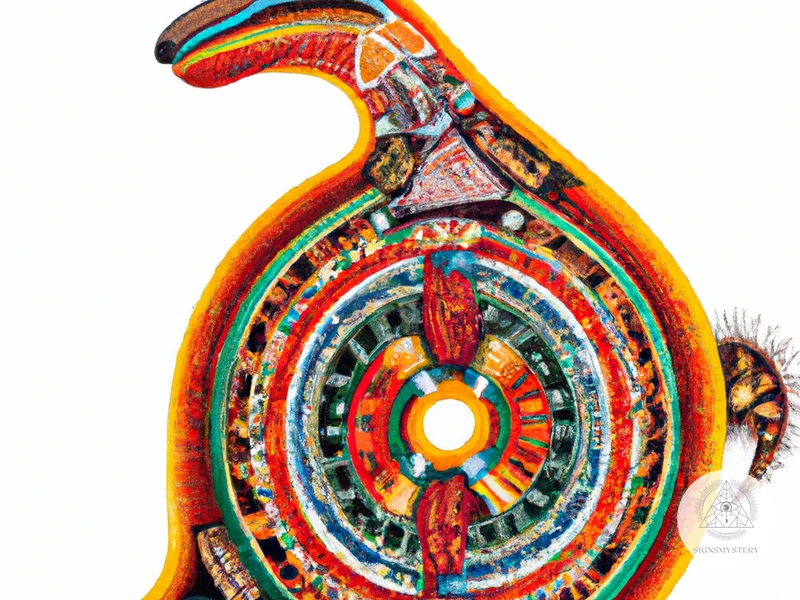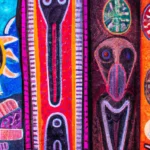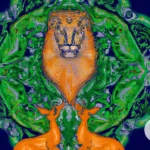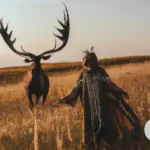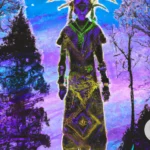The Mystical World of Australian Aboriginal Totems: Unveiling the Symbolism and Spiritual Practices
Deep within the rich and ancient cultural tapestry of Australia lie the sacred totems of the Aboriginal people. These totems are powerful symbols that connect individuals and communities to the spiritual realm and the natural world. Each totem carries a specific meaning and represents ancestral powers, personal and communal identity, and offers guidance and protection. In this captivating exploration, we delve into the profound symbolism of Australian Aboriginal totems and uncover the rituals and practices that have been passed down through the generations. Join us on this enlightening journey as we immerse ourselves in the rich tapestry of Aboriginal spirituality and discover the profound significance of these mystical totems.
A Brief Overview of Australian Aboriginal Totems
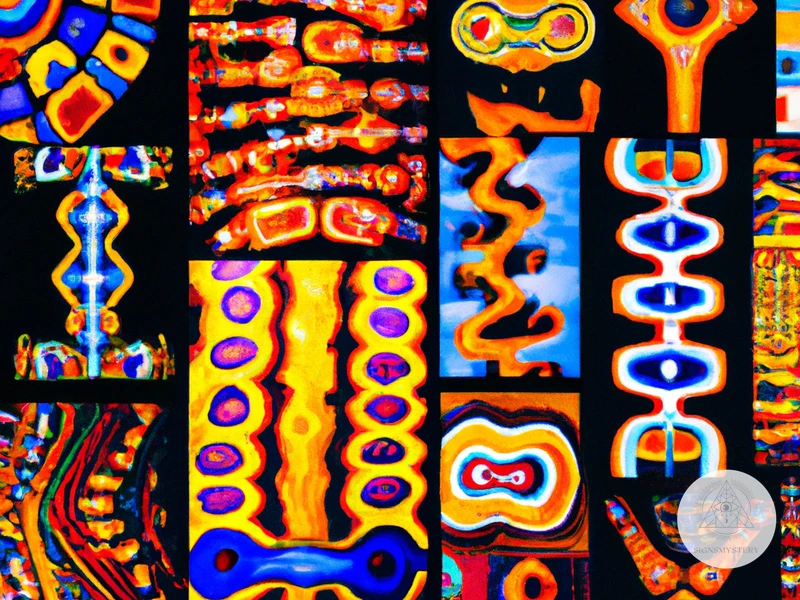
Australian Aboriginal totems have been an integral part of indigenous culture for thousands of years. These totems are representative of specific animals, plants, or even celestial bodies, and are believed to possess deep spiritual significance. They serve as a connection between the physical and spiritual world, bridging the gap between humans and the natural environment around them.
In Aboriginal culture, the choice of totem is often inherited from one’s ancestors, passed down through generations. Each individual is assigned a specific totem based on familial lineage, which becomes an essential aspect of their identity. This totem represents not only the personal identity of the individual but also their connection to their community and the broader Aboriginal culture.
Totems hold great spiritual significance for the indigenous people, as they believe that each totem embodies the power and characteristics of the animal or object it represents. These totems are seen as sacred forms of guidance and protection, offering wisdom and knowledge to those who align themselves with them. They are believed to be channels through which ancestral powers can flow, providing a sense of connection to the spiritual realm and the natural world.
Australian Aboriginal totems are not just passive symbols; they are interactive and dynamic entities in the spiritual practices of the indigenous culture. They are honored and celebrated in various rituals and ceremonies, where the community comes together to acknowledge and pay respect to these sacred symbols. The significance of each totem is deeply ingrained in the Aboriginal way of life, embodying a sense of history, tradition, and spirituality.
For a more comprehensive understanding of the meanings and symbolism of specific Aboriginal totems, refer to our article on Aboriginal Totems and their Meanings. Join us as we delve deeper into the intricacies of these totems and explore their cultural significance.
The Role of Totems in Australian Aboriginal Spirituality
Totems hold a significant role in Australian Aboriginal spirituality, providing a deep and profound connection to the spiritual realm and the natural world. These sacred symbols are believed to embody ancestral powers and serve as conduits for spiritual guidance and protection. The role of totems is multifaceted, contributing to the individual’s sense of personal and communal identity. They are inherited through familial lineage, creating a strong bond between generations and fostering a sense of belonging. Totems also act as channels for communication and interaction with the spiritual realm, enabling individuals to seek guidance and wisdom. Rituals and practices involving totems, such as dreamtime communing and divination, further enhance the spiritual connection and understanding. By understanding the role of totems in Australian Aboriginal spirituality, we gain insight into the profound significance they hold within the indigenous culture and their integral role in shaping beliefs and practices. For more information on animal spirit guides from other cultures, you can explore our article on Ancient African Animal Spirit Guides.
Connection to Ancestral Powers
Connection to Ancestral Powers
Aboriginal totems play a vital role in the connection between individuals and their ancestral powers. The indigenous people believe that their totems are not merely symbols but actual channels through which the wisdom and energy of their ancestors flow. Each totem represents a specific ancestral lineage, carrying the collective knowledge and experiences of those who came before.
The connection to ancestral powers through totems is deeply spiritual and profound. By aligning oneself with their designated totem, individuals tap into the wisdom, guidance, and strength of their ancestors. This connection goes beyond the physical realm and allows them to access the spiritual energies and insights that have been passed down through generations.
It is believed that by honoring and respecting their totems, individuals can establish a strong link to their ancestral lineage. This connection acts as a source of support and guidance, providing a sense of identity and purpose. Through rituals, ceremonies, and personal practices, individuals seek to strengthen this connection and deepen their understanding of the spiritual essence that their totem represents.
For those seeking to explore further ways of connecting with their ancestral energies and totems, the Spirit Animal Crystal Ritual serves as a powerful and transformative practice. By combining the energies of specific crystals with the essence of one’s totem, individuals can enhance their connection to their ancestral powers and tap into the profound guidance and wisdom that flows through these sacred channels.
Representing Personal and Community Identity
One of the fundamental roles of Australian Aboriginal totems is their ability to represent both personal and community identity. To the Aboriginal people, these totems are much more than mere symbols; they embody a deep sense of belonging and connection to one’s ancestry and community. Each individual is assigned a specific totem based on their familial lineage, which becomes an integral part of their personal identity.
The totem serves as a way for individuals to understand their place within the larger context of their community and the broader Aboriginal culture. It is a marker of their roots, connecting them to their ancestors and the traditions that have been passed down through generations. This connection to one’s totem contributes to a sense of purpose and belonging, fostering a strong bond between individuals and their community.
In addition to personal identity, totems also play a significant role in shaping community identity. They serve as a unifying force, bringing individuals together under a shared symbol or emblem. Communities often gather for ceremonies, celebrations, and rituals to honor and pay respect to their collective totems. These gatherings strengthen the communal ties and create a sense of unity and belonging among the people.
The symbolism of totems extends beyond individual and community identity; it also encompasses the broader Aboriginal culture and heritage. Each totem represents a specific aspect of the natural world, be it an animal, a plant, or a celestial body. By acknowledging and embracing their totems, Aboriginal people maintain a deep connection to the land, the environment, and the spiritual forces that govern them.
Australian Aboriginal totems play a crucial role in representing both personal and community identity. These sacred symbols connect individuals to their ancestral lineage, provide a sense of belonging, and foster unity within the community. As the Aboriginal people continue to honor and respect their totems, they ensure the preservation and celebration of their unique cultural heritage.
Guidance and Protection
Guidance and protection are fundamental aspects of Australian Aboriginal totems. These sacred symbols are believed to provide individuals and communities with spiritual guidance and a sense of protection.
1. Wisdom and Direction: Aboriginal totems are seen as wise entities that offer guidance and direction to those who align themselves with them. The characteristics and behaviors of the animal or object represented by the totem are believed to hold valuable lessons and teachings. Individuals look to their totem for insight and advice, trusting that their ancestral powers will guide them along their life’s journey.
2. Cultural Identity and Connection: Aboriginal totems play a crucial role in nurturing a sense of cultural identity and connection. By aligning themselves with their totem, individuals strengthen their bond with their Aboriginal heritage and traditions. They feel a deep connection to the land, animals, and natural elements associated with their totem, fostering a profound sense of belonging and rootedness within their community.
3. Protection and Warding Off Negative Energies: Aboriginal totems are believed to offer protection against negative energies and spiritual harm. It is believed that each totem possesses an inherent power that shields individuals from malevolent forces and keeps them safe. Indigenous people express their reverence for their totems through rituals and ceremonies, seeking their protection and invoking their sacred powers.
4. Harmonizing with Nature: Totems also encourage individuals to recognize their place within the natural world and to live in harmony with it. Aboriginal cultures emphasize the interconnectedness of all living beings, where humans are considered an integral part of the ecosystem. By honoring and respecting their totems, individuals strive to embody the qualities of their totem and align themselves with the natural balance of the environment.
Australian Aboriginal totems hold immense spiritual significance, offering guidance, protection, and a deeper understanding of one’s place within the universe. These sacred symbols are a testament to the profound connection between the spiritual and physical realms and reflect the rich cultural heritage of the indigenous peoples of Australia.
Understanding the Symbolism of Specific Totems
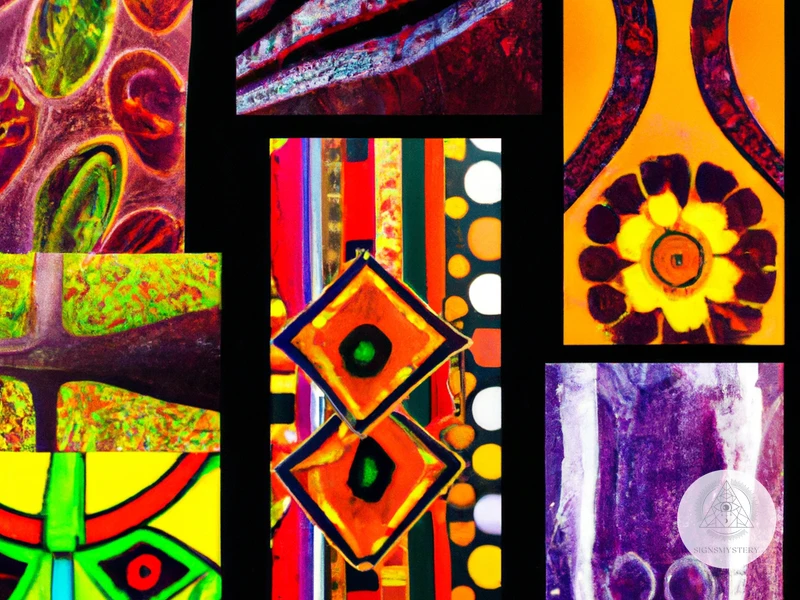
The symbolism behind specific Australian Aboriginal totems holds deep significance and carries powerful messages. Let’s explore some of these totems and their meanings:
1. Kangaroo: Symbolizing strength and agility, the kangaroo totem is associated with resilience and adaptability. It represents the ability to navigate through life’s challenges with grace and speed.
2. Eagle: The eagle serves as a messenger between the spiritual and physical realms. It is a symbol of wisdom, vision, and foresight, guiding individuals towards higher perspectives and spiritual growth.
3. Snake: Representing transformation and healing, the snake totem reminds us of the cyclical nature of life. It symbolizes the shedding of old patterns and embracing personal growth and rejuvenation.
4. Kookaburra: Known as the sign of communication and laughter, the kookaburra totem represents joy, social connection, and the power of laughter to bring people together. It reminds us to find humor and lightness in life.
5. Turtle: Emblematic of longevity and wisdom, the turtle totem signifies patience, protection, and a deep connection to the earth. It teaches us to navigate life’s challenges with a steady and grounded approach.
These specific totems, among many others in Aboriginal culture, carry profound meanings and serve as sources of guidance, inspiration, and spiritual insight. Embracing their symbolism can offer a deeper understanding of oneself and the world around us.
Kangaroo: Symbol of Strength and Agility
Kangaroo, a remarkable creature of the Australian outback, holds a deep symbolic meaning in Aboriginal culture. Revered for its strength and agility, the kangaroo embodies qualities that are highly valued in Aboriginal spirituality.
Strength: The kangaroo’s symbol of strength resonates with the physical power and resilience needed to survive in harsh environments. Aboriginal people draw inspiration from the kangaroo’s ability to adapt and endure, seeing it as a reminder to embrace inner strength during challenging times. The kangaroo’s robust physique is a symbol of tenacity and the ability to overcome obstacles.
Agility: Known for its incredible speed and agility, the kangaroo represents adaptability and quick thinking. In Aboriginal spiritual practices, the kangaroo serves as a reminder to be nimble and open-minded when navigating life’s complexities. It encourages individuals to embrace change and find creative solutions in the face of adversity.
This unique marsupial is also associated with hunting and gathering, as it was an essential source of food and materials for the Aboriginal people. The kangaroo’s role in sustaining communities further illustrates its significance as a totem representing resilience and resourcefulness.
In Aboriginal art, the kangaroo is often depicted using intricate dot paintings or detailed carvings. These artworks capture the essence of the kangaroo’s strength and agility, paying homage to its sacred symbolism within the community. The kangaroo totem embodies a profound connection to the land and serves as a reminder of the ancestral relationship between humans and the natural world.
The kangaroo symbolizes the importance of adaptability, resilience, and mental agility in Aboriginal spirituality. Its representation as a totem highlights the deep reverence many Aboriginal people hold for the natural world and the wisdom they glean from observing its inhabitants.
Eagle: Messenger Between Spiritual and Physical Realms
In Australian Aboriginal spirituality, the eagle holds a special place as a totem representing the connection between the spiritual and physical realms. The eagle is revered for its majestic presence, powerful vision, and ability to soar high in the sky, symbolizing a higher perspective and spiritual insight.
The eagle is considered a messenger between humans and the divine, carrying prayers and messages from the earthly realm to the spiritual realm. It is believed that the eagle can communicate with the ancestral spirits, acting as a bridge between the two worlds. This connection to the spiritual realm grants the eagle a significant role in spiritual ceremonies and rituals.
The eagle’s keen eyesight also represents the ability to see beyond the surface and perceive deeper truths and hidden meanings. It is associated with clarity of vision, wisdom, and intuition, urging individuals to tap into their inner guidance and trust their instincts. The eagle teaches the importance of maintaining a balance between earthly responsibilities and spiritual growth.
This totem holds immense symbolism in Aboriginal spirituality, reflecting the idea that humans are not separate from nature but deeply interconnected with all living beings. The eagle’s ability to fly high in the sky encourages individuals to elevate their consciousness, expand their perspective, and embrace their connection to the spiritual dimensions.
Below is a table summarizing the symbolism associated with the eagle totem:
| Symbol | Meaning |
|---|---|
| Messenger | The eagle acts as a messenger between the spiritual and physical realms, carrying prayers and messages. |
| Clarity | The eagle’s sharp eyesight represents clarity of vision, wisdom, and the ability to perceive hidden truths. |
| Intuition | By trusting their instincts, individuals can tap into their inner guidance and embrace their spiritual growth. |
The eagle totem serves as a reminder for individuals to stay connected to their spiritual essence, seek higher truths, and maintain a harmonious balance between the physical and spiritual aspects of life. Embracing the eagle’s symbolism can bring profound insights, greater awareness, and a deeper connection to the spiritual realms within Aboriginal spiritual practices.
Snake: Symbol of Transformation and Healing
In Australian Aboriginal spirituality, the snake is a powerful totem that represents transformation and healing. This slithering creature is revered for its ability to shed its skin and emerge renewed, which serves as a metaphor for personal growth and spiritual transformation. The snake’s ability to navigate through narrow spaces and move silently symbolizes adaptability and resilience, teaching individuals the importance of embracing change and overcoming obstacles in their own lives.
The Australian Aboriginal people believe that the snake possesses healing properties and holds the knowledge of herbal remedies and medicinal plants. It is associated with the concept of balance and harmony, as it moves seamlessly between the physical and spiritual realms. The snake is seen as a guide in the journey of self-discovery and healing, encouraging individuals to tap into their inner wisdom and embrace the transformative power within themselves.
In Aboriginal culture, snake totems are often seen as protectors and guardians, capable of warding off negative energies and promoting spiritual well-being. They are believed to possess a deep connection to the land and carry the ancestral knowledge of their surroundings. Aboriginal communities hold great respect for snakes and celebrate their presence in various ceremonies and rituals.
The snake’s symbolism extends beyond the individual level and encompasses the broader community as well. It reminds Aboriginal communities of the importance of unity and support, encouraging them to come together during times of transformation and healing. The snake totem serves as a reminder of the interconnectedness of all living beings and the need to embrace change as a collective.
Embracing the symbolism of the snake totem can bring about personal growth, healing, and a deeper sense of connection to the natural and spiritual worlds. By looking to the snake as a guide, individuals can draw inspiration from its transformative qualities and work towards achieving balance, both internally and externally.
Kookaburra: Sign of Communication and Laughter
The Kookaburra holds a special place within the realm of Australian Aboriginal totems, symbolizing communication and laughter. This unique and iconic bird, known for its distinct laughing call, is believed to bring a sense of joy and connection to those who embrace its symbolism.
In Aboriginal spirituality, the Kookaburra’s laughter is seen as a form of communication between the spiritual and physical realms. It is believed that when a Kookaburra is heard laughing, it is a sign of good fortune and positive energy flowing through the environment. The bird’s laughter is seen as a form of divine communication and a reminder to find humor and joy in life.
The Kookaburra’s presence in a person’s life as a totem signifies their ability to connect and communicate effectively with others. It encourages individuals to use laughter as a means of fostering harmonious relationships and open lines of communication. The Kookaburra teaches the importance of finding delight and mirth in everyday experiences, promoting a lighthearted approach to life’s challenges.
This totem also serves as a reminder to maintain a healthy balance between work and play. The Kookaburra’s laughter encourages individuals to take breaks, engage in leisure activities, and find moments of joy and amusement in their daily routines. It reminds people not to take themselves too seriously and to embrace the lighter side of life.
In the Aboriginal culture, the Kookaburra is often celebrated through storytelling and art. Its image is commonly depicted in traditional paintings, carvings, and other artistic creations, serving as a visual representation of the significance of communication and laughter.
Embracing the Kookaburra as a totem invites individuals to embrace a spirit of laughter and open communication in their lives. It encourages them to find humor in challenging situations and to foster meaningful connections with others. By understanding and honoring the symbolic meaning of the Kookaburra, individuals can tap into its energy and bring more laughter and joy into their spiritual journeys.
Turtle: Emblem of Longevity and Wisdom
The turtle holds a special place among Australian Aboriginal totems, symbolizing both longevity and wisdom. In Aboriginal culture, the turtle is revered for its ability to live for many years and adapt to different environments. It is seen as a powerful guide, offering insights into the cycles of life and the importance of patience and perseverance.
The turtle’s association with longevity stems from its ability to live both on land and in water. This duality represents the balance between the physical and spiritual worlds, emphasizing the need for harmony and interconnectedness. The turtle teaches the value of taking things slow and embracing the journey, rather than rushing towards a destination.
Wisdom is another significant attribute associated with the turtle. Indigenous communities recognize the turtle as a source of profound knowledge and understanding. It embodies the wisdom of ancient ancestors and serves as a reminder to seek wisdom from the past while navigating the present. The turtle’s deliberate and deliberate movements remind individuals to approach life’s challenges with thoughtfulness and clarity.
The interconnectedness of the turtle with the natural world is also a crucial aspect of its symbolism. Aboriginal cultures highlight the turtle’s ability to navigate through different environments and adapt to changing circumstances. This adaptability reflects the importance of being in tune with one’s surroundings, acknowledging the interconnectedness of all living beings and the environment they inhabit.
In Aboriginal spirituality, individuals who align themselves with the turtle totem often possess qualities such as patience, resilience, and a deep understanding of the interconnectedness of all things. They are known for their ability to impart wisdom and guidance to others, drawing upon the turtle’s symbolic teachings.
Welcoming the turtle into one’s life and spiritual practice involves acknowledging its wisdom and embodying its traits. This can be done through ceremonies, rituals, or even by creating artwork inspired by the turtle’s symbolism. By honoring the turtle, individuals can connect with its energy and embrace the lessons it offers in terms of longevity, wisdom, adaptability, and interconnectedness.
Explore our article on Spirit Animal Crystal Ritual for a unique way to incorporate the energy of the turtle into your spiritual practices. Immerse yourself in the world of the turtle and discover the profound teachings it has to offer.
Common Rituals and Practices Involving Aboriginal Totems
Aboriginal totems play a central role in the rituals and practices of Indigenous Australians, serving as meaningful symbols in their spiritual journey. One common ritual involving totems is the act of welcoming and acknowledging these sacred symbols. This ritual involves expressing gratitude and respect towards the totem, recognizing its power and significance. Additionally, totems are communed with in Dreamtime, a spiritual state where one connects with the ancestral realm through dreams and visions. Aboriginal individuals seek guidance and messages from their totems during these experiences. Totems are also used for guidance and divination, where individuals seek answers to important questions and insights into their lives. The creative expression of totem symbols through art and crafts is another important practice in Aboriginal culture, allowing individuals to connect with their totem and express their spirituality in a tangible form. These rituals and practices involving Aboriginal totems reflect the deep reverence and connection Indigenous Australians have with their spiritual beliefs and the natural world around them.
Welcoming and Acknowledging Totems
In Australian Aboriginal spirituality, the process of welcoming and acknowledging totems is a deeply meaningful and significant ritual. It is a way of honoring and showing respect to the spiritual essence of the totem and establishing a connection with its power and wisdom.
When an individual or a community encounters a totem, whether in the physical form or through a spiritual experience, it is customary to pause and acknowledge its presence. This can be done through various practices such as song, dance, or verbal acknowledgment. By acknowledging the totem, one is essentially extending an invitation for it to communicate and share its guidance with them.
During the welcoming ritual, individuals may also offer gifts or create symbolic representations of the totem as a sign of reverence. These offerings can include items like
Subscribe to Our Newsletter
Sign up to receive the latest news and updates.
The practice of welcoming and acknowledging totems goes beyond just the physical encounter. It extends to the dreamtime, the Aboriginal concept of the spiritual realm where past, present, and future exist simultaneously. In the dreamtime, individuals may have visions or dreams involving their totems, and these experiences are seen as a form of communication and guidance from the spiritual realm.
By actively welcoming and acknowledging totems, individuals and communities open themselves up to the wisdom and teachings that these sacred symbols embody. It is a way of embracing the interconnectedness of all beings and recognizing the significance of the natural world in Aboriginal spirituality.
For more information on rituals and practices involving Aboriginal totems, including their use in divination and guidance, refer to our article on Ancient African Animal Spirit Guides. Join us as we explore the mystical aspects of totems and the profound role they play in Australian Aboriginal spirituality.
Communing with Totems in Dreamtime
Communing with totems in Dreamtime is a sacred practice deeply rooted in Australian Aboriginal spirituality. Dreamtime, also known as the “Eternal Now,” is a concept that encompasses the creation of the world and the ongoing spiritual connection between all living beings. It is believed that during Dreamtime, the spiritual and physical realms converge, allowing individuals to connect with their totems on a profound level.
In the Aboriginal belief system, Dreamtime is seen as a timeless and continuous state of existence where ancestral spirits are accessible. The totems, being representative of these ancestral spirits, are regarded as portals to the Dreamtime. This spiritual practice involves going into a deep meditative state, transcending the boundaries of time and space, and entering the realm of the totem.
When communing with a totem in Dreamtime, individuals seek guidance, wisdom, and spiritual insight. They may visualize themselves as the totem, allowing their consciousness to merge with the essence of the animal or object. This connection opens pathways for communication with the ancestral spirits associated with the totem, who may offer messages, visions, or symbols.
During these visionary experiences, individuals may receive teachings, revelations, or even warnings from their totems. The messages received in Dreamtime are considered highly significant and may guide individuals in their personal lives, decision-making, or spiritual growth. This practice fosters a profound sense of connection and reverence for the totem and its spiritual teachings.
Communing with totems in Dreamtime is a deeply personal practice, often done in solitude or with the guidance of an experienced elder or spiritual mentor. It requires surrendering oneself to the spiritual realm and allowing the wisdom and energy of the totem to flow through. Through this practice, individuals can gain a deeper understanding of their place in the world, connect with their ancestral heritage, and receive guidance from the powerful forces intertwined with their totem.
It is important to note that Dreamtime practices and interpretations vary among different Aboriginal groups, as each tribe has its own unique traditions, rituals, and understanding of totems. Respectful engagement with Aboriginal communities and seeking proper guidance ensures cultural sensitivity and authenticity in exploring the practice of communing with totems in Dreamtime.
In the next section, we will explore another facet of the significance of Aboriginal totems: using them as a tool for guidance and divination.
Using Totems for Guidance and Divination
Using Totems for Guidance and Divination:
1. Animal Totem Readings: Aboriginal cultures believe that each animal totem carries specific qualities and energies that can provide guidance and insight into different aspects of life. One way to use totems for guidance and divination is through animal totem readings. This involves connecting with a specific totem animal and seeking its wisdom in relation to a particular situation or question. Whether through meditation, dream interpretation, or observing the behavior of animals in nature, individuals can tap into the messages and symbolism of their animal totems.
2. Symbolic Interpretation: Aboriginal totems are rich in symbolism, and their meanings go beyond the physical attributes of the animals or objects they represent. Engaging in symbolic interpretation of totems involves exploring the deeper meanings associated with each totem and relating them to personal experiences or challenges. For example, if someone connects with the snake totem, they might interpret it as a symbol of transformation and healing. By reflecting on the qualities and symbolism of their chosen totem, individuals can gain insights and guidance on their spiritual journey.
3. Rituals and Ceremonies: Aboriginal cultures often incorporate totems into rituals and ceremonies as a means of seeking guidance and spiritual connection. These rituals can include dances, songs, and storytelling that invoke the power and energy of the totem. By participating in these rituals, individuals can strengthen their bond with their chosen totem and harness its guidance and protective energies.
4. Divination Tools: In addition to animal totems, Aboriginal cultures also utilize divination tools linked to their totems. These tools can include shells, stones, or bones, each representing a specific totem and its associated qualities. Through various divination practices, such as casting the bones or interpreting the patterns formed by the shells, individuals can seek answers to their questions and gain insights into the challenges they may be facing.
By using totems for guidance and divination, individuals can tap into the ancient wisdom and spiritual energies that these symbols embody. It allows for a deeper understanding of oneself, the environment, and the interconnectedness of all living beings. Whether through animal readings, symbolic interpretation, rituals, or divination tools, the use of totems in guidance and divination practices offers a profound way to access spiritual insights and seek guidance on life’s journey.
Creating Art and Crafts Inspired by Totem Symbols
Aboriginal totem symbols hold immense artistic inspiration, leading to the creation of mesmerizing art and crafts that reflect the spiritual significance of these sacred entities. Through the use of various mediums such as painting, woodworking, weaving, and carving, indigenous artists skillfully depict the essence of totem symbols, breathing life into their representations.
One popular form of art inspired by Aboriginal totems is dot painting, a technique that involves the intricate application of tiny dots to create vibrant and intricate designs. The dots not only add visual appeal but also carry symbolic meaning. The patterns and colors used in these artworks often reflect the specific totem being depicted, as well as the artist’s personal interpretation and connection to it.
Woodcarving is another prominent medium used to bring totem symbols to life. Skilled craftsmen carefully carve intricate designs into wood, showcasing the unique characteristics of each totem. These wooden sculptures serve as powerful representations of the spiritual energy and significance associated with the totem, honoring its presence and symbolism.
Weaving is also deeply intertwined with Aboriginal culture, and it is often used to create intricate baskets, mats, and other woven crafts. Artists incorporate totem symbols into their weaving, using traditional techniques passed down through generations. These woven creations not only showcase the artistic abilities of the indigenous community but also serve as tangible connections to the spiritual and cultural heritage of the totem.
Through the creation of art and crafts inspired by totem symbols, Aboriginal artists pay homage to their ancestral connection and spiritual beliefs. Each piece serves as a visual expression of the deep reverence and respect held for these sacred entities, allowing them to be shared and appreciated by a wider audience.
To explore more about the spiritual connection between indigenous cultures and art, you may be interested in our article on Spirit Animal and Crystal Ritual, which delves into the mystical relationship between spirituality, animals, and metaphysical practices. Join us as we unravel the beautiful intersection of art and Aboriginal totem symbolism, and discover the profound impact of these creations on the cultural landscape.
Contemporary Significance and Respect for Aboriginal Totems

The contemporary significance and respect for Aboriginal totems continue to play a vital role in Australian society. As the nation grapples with issues of reconciliation and cultural understanding, there is a growing recognition of the importance of honoring and preserving the traditions and beliefs of the Aboriginal people.
In recent years, there has been a resurgence of interest in Aboriginal spirituality and the symbolism of totems. Many individuals, both indigenous and non-indigenous, have embraced the practice of identifying their personal totem and connecting with its spiritual energy. This newfound interest has led to a deeper appreciation for the wisdom and guidance that totems offer.
Respecting Aboriginal totems goes beyond mere acknowledgment; it involves actively engaging with the culture and seeking permission to access and understand its sacred symbols. Cultural protocols and traditional practices must be respected when using totems for personal or spiritual purposes. This includes seeking guidance from Aboriginal elders and community members who hold the knowledge and wisdom surrounding these totems.
Supporting indigenous artists and artisans who create artworks inspired by totems is another way of showing respect and appreciation. By purchasing their works, individuals contribute to the preservation of Aboriginal culture and the economic empowerment of Aboriginal communities.
It is essential to approach Aboriginal totems with reverence and a willingness to learn. By cultivating a deep respect for these symbols and their cultural significance, we can contribute to the ongoing preservation and celebration of Aboriginal spirituality. When non-indigenous individuals engage with Aboriginal totems in a respectful manner, it fosters a sense of unity and mutual understanding between cultures.
To gain further insight into the significance of totems across different indigenous cultures, you may also be interested in exploring the concept of ancient African animal spirit guides. Understanding the similarities and differences in how various cultures interpret and connect with animal symbolism can broaden our appreciation for the diverse ways in which totems are revered worldwide.
Recognizing and respecting Aboriginal totems is an integral part of cultural appreciation and understanding. By honoring the spirituality and symbolism they represent, we can contribute to the preservation of indigenous wisdom and further bridge the gap between communities. Let us embrace the contemporary significance of Aboriginal totems and engage in practices that foster respect and unity.
Conclusion
Unveiling the Wisdom of Australian Aboriginal Totems
The world of Australian Aboriginal totems is a mesmerizing blend of spirituality, symbolism, and cultural heritage. These sacred symbols, representing animals, plants, and celestial bodies, hold deep meaning and power for the indigenous people. Through their totems, they connect with their ancestral powers, establish personal and community identity, seek guidance and protection, and engage in various rituals and practices.
By exploring the symbolism of specific totems like the Kangaroo, Eagle, Snake, Kookaburra, and Turtle, we gain insight into the unique characteristics and qualities associated with each animal. These totems embody strength, agility, wisdom, and healing, providing individuals with a deeper understanding of themselves and their place in the world.
The rituals and practices involving Aboriginal totems, such as welcoming and acknowledging them, communing with them in Dreamtime, using them for guidance and divination, and expressing their symbolism through art and crafts, are all ways in which the indigenous people honor and interact with these sacred symbols.
In contemporary times, there is an increasing recognition and respect for Australian Aboriginal totems. They are not only valued within the indigenous community but also appreciated by people from diverse backgrounds who seek a deeper connection with nature and spiritual realms. By embracing and appreciating the wisdom embedded in Aboriginal totems, we can enhance our own understanding of the natural world and cultivate a sense of reverence for all living beings.
In conclusion, the exploration of Australian Aboriginal totems reveals a profound interconnectedness between humans and the natural world. These symbolic representations act as gateways to spiritual realms, offering guidance, protection, and a deeper understanding of ourselves and our environment. Let us embrace the wisdom of these totems and celebrate the rich cultural heritage of the indigenous people of Australia.
Frequently Asked Questions
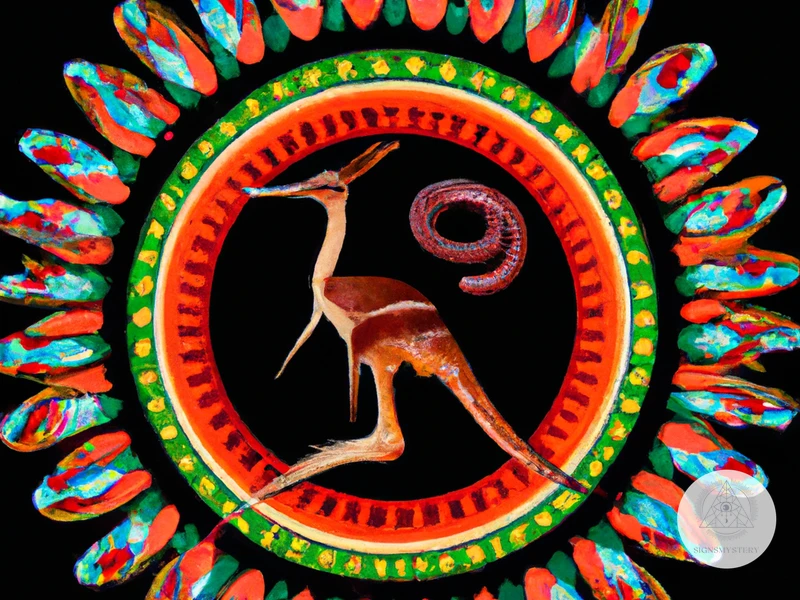
1. What is the significance of Australian Aboriginal totems?
Australian Aboriginal totems hold deep spiritual significance as they represent the connection between individuals, communities, and the natural world. They embody ancestral powers, personal and community identity, and offer guidance and protection.
2. How are Aboriginal totems chosen?
Aboriginal totems are often inherited from ancestors and passed down through generations based on familial lineage. The choice of totem is a significant part of an individual’s identity within their community.
3. Do different Aboriginal clans have different totems?
Yes, different Aboriginal clans can have different totems. Totems are closely tied to specific familial lineages and can vary between different clans and regions.
4. Can a person have multiple totems?
While it is more common for an individual to have one primary totem, it is possible for a person to have multiple totems, especially if they have a complex ancestral lineage or connections to different animal or plant symbols.
5. How do Aboriginal people honor their totems?
Aboriginal people honor their totems through various rituals and ceremonies. These may include offerings, dances, songs, and storytelling, all aimed at acknowledging and paying respect to the sacred symbols.
6. Can Aboriginal totems change during a person’s lifetime?
The choice of totem is generally inherited and remains consistent throughout a person’s life. However, in certain circumstances, such as through marriage or significant life events, it is possible for an individual’s totem to change within the Aboriginal cultural framework.
7. Are there restrictions on interacting with certain totems?
Yes, there are often cultural protocols and restrictions associated with specific totems. These may include taboos regarding hunting or using certain animals, or guidelines for appropriate behavior when encountering a particular totem.
8. Can an individual communicate with their totem?
Aboriginal spirituality believes in the ability to communicate with totems through rituals, dreams, and meditation. Individuals may seek guidance or insights from their totem for personal and communal matters.
9. Are Aboriginal totems found in other cultures?
The concept of totems is not unique to Australian Aboriginal culture. Similar beliefs and practices exist in other indigenous cultures around the world, where specific symbols or animals hold spiritual significance.
10. How can non-Indigenous individuals learn about and respect Aboriginal totems?
Non-Indigenous individuals can learn about and respect Aboriginal totems by educating themselves about Indigenous culture and history, listening to and supporting Aboriginal voices, and engaging with Indigenous communities in a respectful and collaborative manner.
References
Frequently Asked Questions

1. How are Australian Aboriginal totems chosen?
Australian Aboriginal totems are not chosen, but rather inherited through family lineage. Totems are passed down from parents or grandparents and are believed to be connected to the individual’s ancestral lineage.
2. Are totems considered sacred in Australian Aboriginal spirituality?
Yes, totems are considered sacred in Australian Aboriginal spirituality. They are seen as powerful spiritual beings that hold important knowledge and connections to the Dreamtime, the ancestral realm.
3. Can an individual have multiple totems?
Yes, it is possible for an individual to have multiple totems. Each totem represents a different aspect of their identity, such as their clan, family, or personal qualities.
4. Do totems have different symbolic meanings across different Aboriginal communities?
Yes, the symbolic meanings of totems can vary across different Aboriginal communities. While some totems may have similar meanings, others may have unique symbolism specific to a particular community’s cultural beliefs and stories.
5. How do Aboriginal people communicate with their totems?
Aboriginal people communicate with their totems through various rituals, ceremonies, and practices. This can include storytelling, dance, music, and connecting with the spirit realm through dreaming or meditation.
6. Are totems considered more than just animal symbols in Aboriginal spirituality?
Yes, in Aboriginal spirituality, totems are more than just animal symbols. They are seen as living beings with inherent spiritual power and connection to the Dreamtime. They embody the essence of their respective qualities and are revered as spiritual guides and protectors.
7. Are totems only associated with animals in Aboriginal culture?
No, in Aboriginal culture, totems can be associated with animals, plants, natural phenomena, and even ancestral spirits. These totems represent a wide range of qualities, characteristics, and forces in the spiritual and natural world.
8. Are totems relevant in modern Aboriginal practices?
Yes, totems still hold great significance in modern Aboriginal practices. They serve as a way to maintain cultural identity, connect with ancestral knowledge, and provide guidance and protection in contemporary Aboriginal life.
9. Can individuals change their totems during their lifetime?
No, individuals cannot change their totems during their lifetime. Totems are inherited and remain constant throughout an individual’s life. However, they can develop deeper connections with their totems over time and gain a greater understanding of their symbolism and significance.
10. How do non-Aboriginal individuals respectfully engage with Aboriginal totems?
Non-Aboriginal individuals can respectfully engage with Aboriginal totems by learning about and acknowledging their significance in Aboriginal culture. It is important to approach totems with reverence, seeking permission when interacting with them, and honoring the cultural protocols and practices associated with them.

